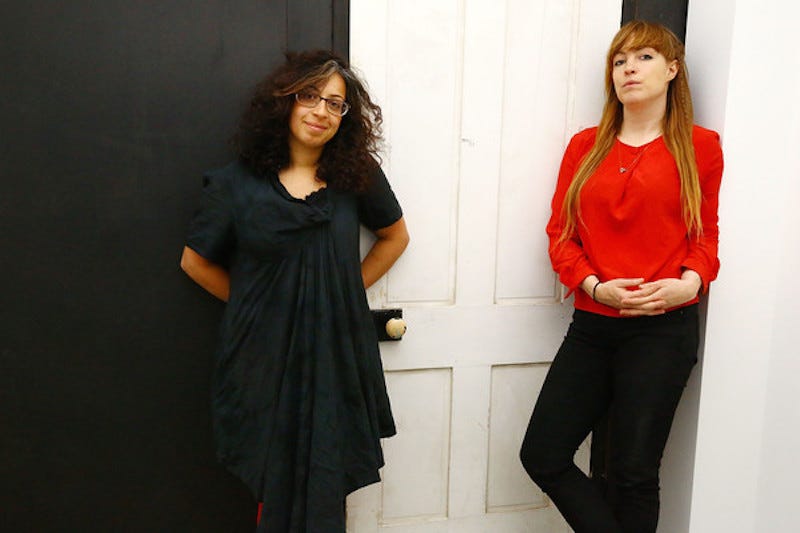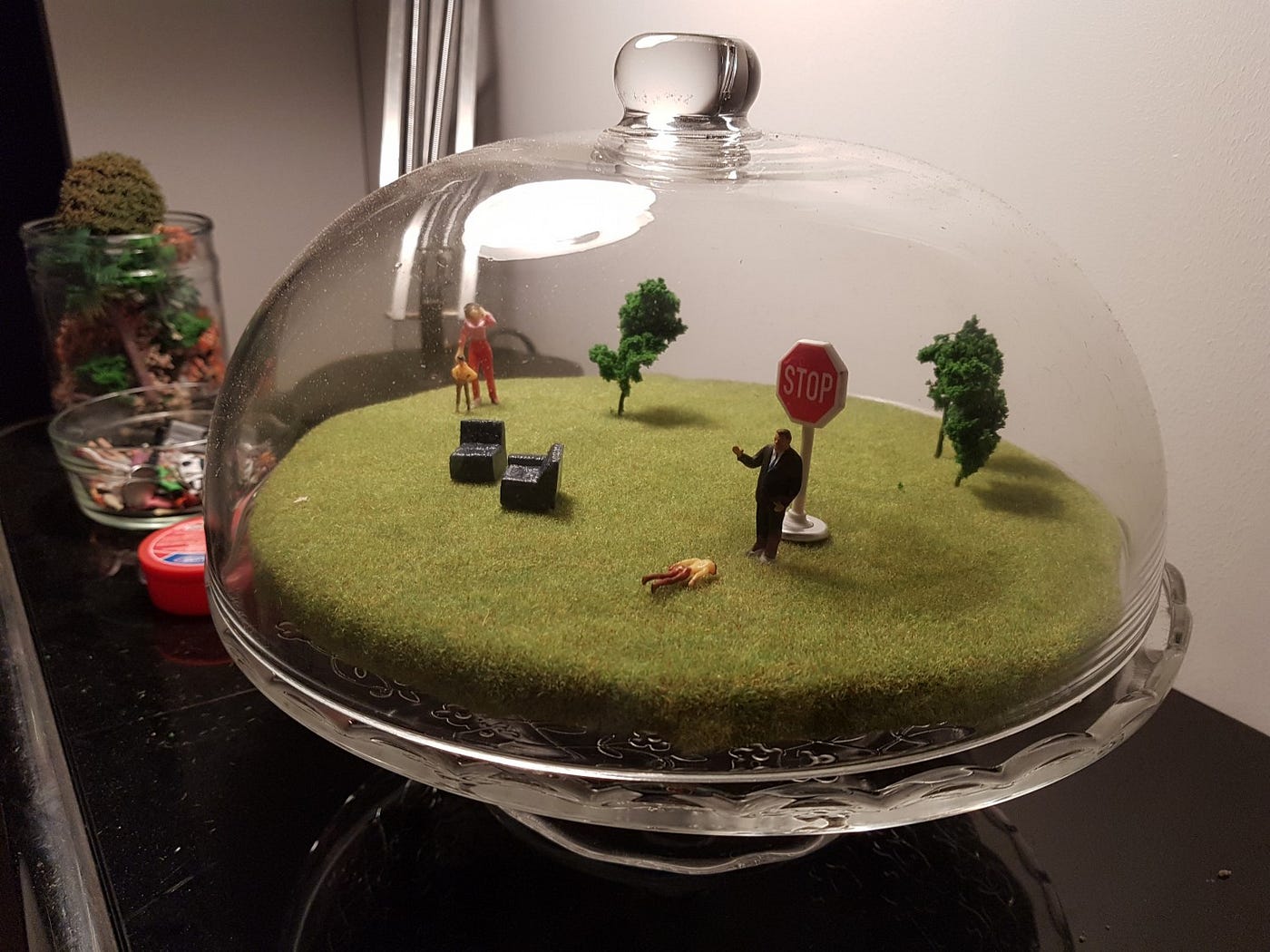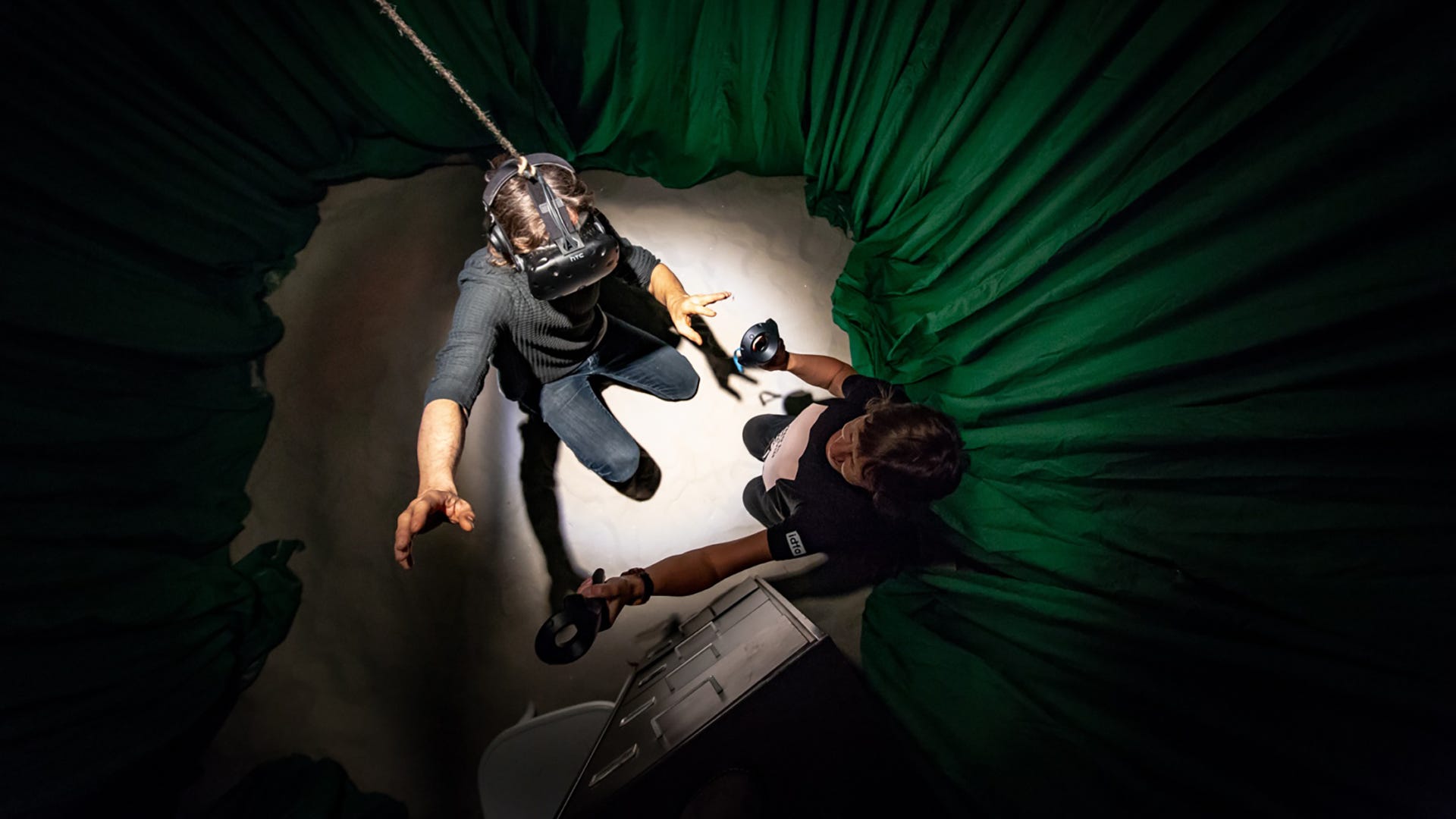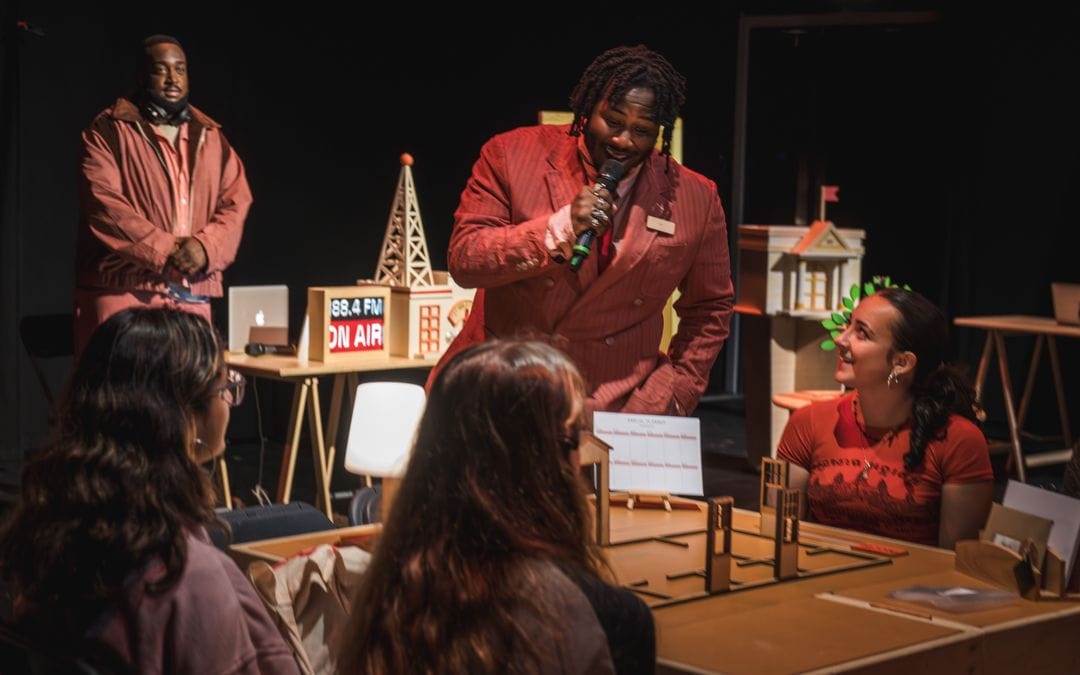The Collider, created by Bristol-based Anagram, is a participatory piece for two people at a time. It is unusual in its design; two players go through a physical installation separately before meeting in the same physical space. Once together, they go through a VR experience together, but while sharing the same VR kit between the two of them. The first participant is in the headset, whereas the second participant has access to the VR controllers. The one in the headset can’t see the other participant but the other participant can see them.
The result is a fascinating immersive digital-physical-live experience that explores many of the nuances of human existence: our relationships with others and the resulting issues around power, trust, collaboration, and more. And what happens in The Collider is different every time.
We spoke with Amy Rose and May Abdalla of Anagram over email to learn more ahead of the piece’s premiere at the Tribeca Film Festival’s Virtual Arcade.

No Proscenium (NP): Can you tell us a little about yourselves and Anagram?
Anagram: Before Anagram, we were friends and both had separate careers as documentary filmmakers. We loved making films but felt like there were more parts of a person that could be utilized in the crafting of a story. Particularly, we wanted to bring physical experience into it. As opposed to sitting, watching and imagining someone’s world and experience — the eye’s prerogative — we wanted to play with the feeling you could get in your skin, or in your gut, that might take people into a story in a different, more intimate way.
The projects we make now often involve thinking about a story we want to tell, but also designing how someone will move through it, what they touch, what they do, what is nearby.
We look for any available tools that we can use to connect them viscerally to the heart of what a story is about. Technology, in its various forms, is usually in the mix somewhere, helping these things come alive.
NP: What, in a nutshell, is The Collider about?
Anagram: The Collider is an experience that explores our relationship to power at micro level — where do we stand in the messy push and pull between desiring independence and needing others?
At the heart of each project, we are asking questions. Through crafting the work we hope that participants can explore these questions for themselves; there are no right answers. In The Collider these questions include: what do you do with power? Do you want to hold on to it, or do you want to give it away to someone else? Are we ever complicit in our own weakness in relation to someone else, and is it possible to change?
While these questions could be heavy, we always look for a light way in — mindful that a playful game or moment can open up a thought about something deeper. So the experience of The Collider is couched within the story of the machine:
You are invited to enter The Collider — a machine built to decode the mysteries of human relationships.
Like its better known counterpart, the Large Hadron, The Collider sets out to reveal bonds between unique entities. Although instead of particles, this machine hurls people together.
Its mission: to identify and understand the invisible material that passes between people — the corrosive, delightful, and mysterious matter that keeps us together and pulls us apart.
NP: Why did you create this experience? What inspired you?
Anagram: Two things came together. One was the interaction and the second was the story.
The idea for the interaction came several years ago during one of the first times using a Vive Headset. It happened during the onboarding, whilst waiting in the headset looking at the white empty horizon of the holding screen.
The person facilitating the experience had picked up the controllers for the device and began walking over to me. There was a way that the controllers moved in his invisible hands across the space that was instantly, uniquely human. It was fascinating — what could be sensed or inferred from the movement. I reached out my hands in the direction of the 3D models of the controllers floating in front of me, and my hands and the plastic made contact. Out of one realm into another.
In a second, that was over. The actual experience loaded and I was alone playing the game.
It felt like this merely functional setup had much greater potential to act as a playful device; a metaphor about two people not quite seeing each other’s worlds but being connected.
So we started off playing with splitting the headset and the controllers between two people — which isn’t the usual use of the kit. We experimented with setups that would heighten the relationship and make each person dependent both in a delightful way and then in a more complex way. From having a meal with all the cutlery tied to someone else’s wrists, to mechanical harmonographs that would create patterns based on the movements of two individuals.
During the development of the piece, events took place that lead to a wider conversations about power; the quest for a “strong leader” after the election of Trump and the evidence for how dynamics of domination were accepted through the #MeToo allegations.
Increasingly the piece became more about the will to power and the extraordinary ability of another person to limit your freedom.
NP: How do the physical and virtual components work together to make the experience come to life?
Get Kathryn Yu’s stories in your inbox
Join Medium for free to get updates from this writer.
SubscribeSubscribe
Anagram: The Collider relies on a built set — and there are a series of chambers that, as a participant, you explore and in which you are asked to perform various tasks. Two participants enter separately into separate rooms and slowly make their way towards each other. The heart of the piece is when the two people encounter each other: one in the headset and the other wielding the controllers.

This placement of VR within a built set means that there is a significant chapter before the virtual component begins: preparing both for the encounter to come. In the first space, each participant is asked to construct a scene from their memory out of miniature objects in a glass display case. Of course, everyone’s memory is completely different. There is nothing virtual in the room, but the role of memory in the narrative recurs throughout the rest of the piece — picked up in the visuals and the script as the experience evolves.
Mixing these very different formal elements into the piece, while retaining a coherent narrative line, is emblematic of our practice, and our desire to spark the imagination of the participants with every tool possible.
NP: How does audience drive what happens? What kinds of choices can the participants make?
Anagram: The Collider offers a set of conditions within which two people act. While there is a linear narrative line to follow, what people choose to do, and how people respond to these conditions varies a lot. The most important variable is the people in the room. Who those people are — whether they know each other, the mood they are in, the chemistry between them (not necessarily romantic!) — governs what happens as much as the piece itself. When we presented the piece as a work-in-progress in Amsterdam at the IDFA Doclab in November 2018, we would observe strangers, colleagues, lovers, friends — all sorts of combinations, each offering something different.
At one point, there is an opportunity to dance with one person leading by waving the controllers around, and the other (inside VR) following the apparitions that the movement of the controllers creates. Despite the technological divide created by the headset, you can sense a feeling of joy in the room — they’ve found synchronicity, they’re playing with it — it can get very ridiculous with the right combination… When we’re hiding in the wings, pressing the buttons to make the experience work and tired after hours in the dark backstage, we love it when that happens, and get a blast of energy too.
NP: A person wearing a VR headset can already feel isolated or vulnerable because their vision is blocked. How does The Collider play off these feelings, with safety and consent in mind?
Anagram: People in VR are indeed vulnerable — and we do use that. Most significantly, by creating a sense of protectiveness towards them in the person who is not wearing the headset. It’s very easy, in the presence of a blindfolded person responding manically to invisible stimuli, for them to get an immediate sense of their own power. And once that sensation is real and alive in the space, the experience connects to something.
Of course, safety and consent is critical. The tone of the instructions have to be careful and gentle as well as playful. Both excitement and fear arises from not really knowing what will happen next. For the person in VR, that is also a real sensation which connects this experience — here in the machine — to sensations they might recognise from other encounters in their life.

NP: What’s the audience response been like so far? What’s surprised you in the reactions have you observed?
In the first public iteration of the work-in-progress version of The Collider at IDFA DocLab in November 2018, we were consistently surprised by all the weird and wonderful ways in which people would interact with the set.
When you write a piece that asks participants to follow instructions and you design a set that invites interaction; you start to be attached to what you feel is the right way of doing things.
Sometimes this happens; it runs to your imagined script but there are always the ones who confound you and do something different. This is often delightful, strange and funny. You learn as much about yourself as you do about them. Why would I expect this question to result in this response? It’s a powerful tension between wanting to curate an inner journey with a strong narrative and giving people the freedom to bring their own energies and ideas to the work.
NP: Who is the ideal audience member for this experience?
Anagram: I don’t think there is an ideal audience member. Of course as it is a participatory piece, and someone who is prepared to participate is good. But we make a lot of effort to make experiences which everyone can connect to. At various points, your desire not to participate or be guided is also acknowledged and integrated into the piece. Being uncomfortable or unwilling doesn’t ruin the experience, because that is also part of it.
NP: What do you hope participants take away from The Collider?
Anagram: We are interested in making work that moves people — that connects to something in their life, and opens up a new perspective, even if just for a snatched moment.
Whether that is through humor and absurdity, or through something tender and delicate, the flash of something real in the room is what we are looking for. Having grown up in the documentary world, we are very sensitive to what feels meaningful. And we try and do that without taking ourselves too seriously.
The most beautiful thing we saw coming out of the work-in-progress version at IDFA DocLab was the moments of real connection that happened between the two participants sharing their memories.
The piece stages a series of activities that relate to dynamics we all know and recognize. Recognizing the power dynamics in a room and finding a way to talk about those dynamics on a very personal level is what we are looking to do.
We are in the process of designing an engagement strategy for the piece that will seek audiences who might not usually engage with VR, but for whom the subject matter is resonant. Ultimately, we aim to use The Collider as way of opening up conversations about power between people and how we use it.
The Collider runs April 26 — May 4 as part of the Tribeca Film Festival’s Immersive Program. Tickets are $40 for a 3-hour time slot.
View all of our Tribeca Immersive 2019 coverage.
NoPro is a labor of love made possible by our generous Patreon backers. Join them today!
In addition to the No Proscenium web site, our podcast, and our newsletters, you can find NoPro on Twitter, Facebook, YouTube, Instagram, in the Facebook community Everything Immersive, and on our Slack forum.
Office facilities provided by Thymele Arts, in Los Angeles, CA.




















Discussion